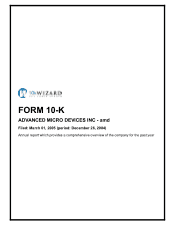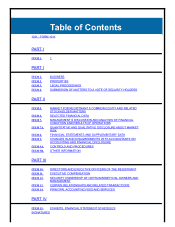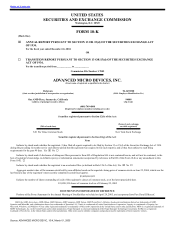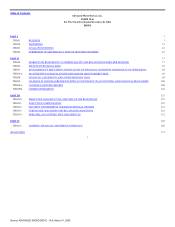AMD 2004 Annual Report Download - page 10
Download and view the complete annual report
Please find page 10 of the 2004 AMD annual report below. You can navigate through the pages in the report by either clicking on the pages listed below, or by using the keyword search tool below to find specific information within the annual report.-
 1
1 -
 2
2 -
 3
3 -
 4
4 -
 5
5 -
 6
6 -
 7
7 -
 8
8 -
 9
9 -
 10
10 -
 11
11 -
 12
12 -
 13
13 -
 14
14 -
 15
15 -
 16
16 -
 17
17 -
 18
18 -
 19
19 -
 20
20 -
 21
21 -
 22
22 -
 23
23 -
 24
24 -
 25
25 -
 26
26 -
 27
27 -
 28
28 -
 29
29 -
 30
30 -
 31
31 -
 32
32 -
 33
33 -
 34
34 -
 35
35 -
 36
36 -
 37
37 -
 38
38 -
 39
39 -
 40
40 -
 41
41 -
 42
42 -
 43
43 -
 44
44 -
 45
45 -
 46
46 -
 47
47 -
 48
48 -
 49
49 -
 50
50 -
 51
51 -
 52
52 -
 53
53 -
 54
54 -
 55
55 -
 56
56 -
 57
57 -
 58
58 -
 59
59 -
 60
60 -
 61
61 -
 62
62 -
 63
63 -
 64
64 -
 65
65 -
 66
66 -
 67
67 -
 68
68 -
 69
69 -
 70
70 -
 71
71 -
 72
72 -
 73
73 -
 74
74 -
 75
75 -
 76
76 -
 77
77 -
 78
78 -
 79
79 -
 80
80 -
 81
81 -
 82
82 -
 83
83 -
 84
84 -
 85
85 -
 86
86 -
 87
87 -
 88
88 -
 89
89 -
 90
90 -
 91
91 -
 92
92 -
 93
93 -
 94
94 -
 95
95 -
 96
96 -
 97
97 -
 98
98 -
 99
99 -
 100
100 -
 101
101 -
 102
102 -
 103
103 -
 104
104 -
 105
105 -
 106
106 -
 107
107 -
 108
108 -
 109
109 -
 110
110 -
 111
111 -
 112
112 -
 113
113 -
 114
114 -
 115
115 -
 116
116 -
 117
117 -
 118
118 -
 119
119 -
 120
120 -
 121
121 -
 122
122 -
 123
123 -
 124
124 -
 125
125 -
 126
126 -
 127
127 -
 128
128 -
 129
129 -
 130
130 -
 131
131 -
 132
132 -
 133
133 -
 134
134 -
 135
135 -
 136
136 -
 137
137 -
 138
138 -
 139
139 -
 140
140 -
 141
141 -
 142
142 -
 143
143 -
 144
144 -
 145
145 -
 146
146 -
 147
147 -
 148
148 -
 149
149 -
 150
150 -
 151
151 -
 152
152 -
 153
153 -
 154
154 -
 155
155 -
 156
156 -
 157
157 -
 158
158 -
 159
159 -
 160
160 -
 161
161 -
 162
162 -
 163
163 -
 164
164 -
 165
165 -
 166
166 -
 167
167 -
 168
168 -
 169
169 -
 170
170 -
 171
171 -
 172
172 -
 173
173 -
 174
174 -
 175
175 -
 176
176 -
 177
177 -
 178
178 -
 179
179 -
 180
180 -
 181
181 -
 182
182 -
 183
183 -
 184
184 -
 185
185 -
 186
186 -
 187
187 -
 188
188 -
 189
189 -
 190
190 -
 191
191 -
 192
192 -
 193
193 -
 194
194 -
 195
195 -
 196
196 -
 197
197 -
 198
198 -
 199
199 -
 200
200 -
 201
201 -
 202
202 -
 203
203 -
 204
204 -
 205
205 -
 206
206 -
 207
207 -
 208
208 -
 209
209 -
 210
210 -
 211
211 -
 212
212 -
 213
213 -
 214
214 -
 215
215 -
 216
216 -
 217
217 -
 218
218 -
 219
219 -
 220
220 -
 221
221 -
 222
222 -
 223
223 -
 224
224 -
 225
225 -
 226
226 -
 227
227 -
 228
228 -
 229
229 -
 230
230 -
 231
231 -
 232
232 -
 233
233 -
 234
234 -
 235
235 -
 236
236 -
 237
237 -
 238
238 -
 239
239 -
 240
240 -
 241
241 -
 242
242 -
 243
243 -
 244
244 -
 245
245 -
 246
246 -
 247
247 -
 248
248 -
 249
249 -
 250
250 -
 251
251 -
 252
252 -
 253
253 -
 254
254 -
 255
255 -
 256
256 -
 257
257 -
 258
258 -
 259
259 -
 260
260 -
 261
261 -
 262
262 -
 263
263 -
 264
264 -
 265
265 -
 266
266 -
 267
267 -
 268
268 -
 269
269 -
 270
270 -
 271
271 -
 272
272 -
 273
273 -
 274
274 -
 275
275 -
 276
276 -
 277
277 -
 278
278 -
 279
279 -
 280
280 -
 281
281 -
 282
282 -
 283
283 -
 284
284 -
 285
285 -
 286
286 -
 287
287 -
 288
288 -
 289
289 -
 290
290 -
 291
291 -
 292
292 -
 293
293 -
 294
294 -
 295
295 -
 296
296 -
 297
297 -
 298
298 -
 299
299 -
 300
300 -
 301
301 -
 302
302 -
 303
303 -
 304
304 -
 305
305 -
 306
306 -
 307
307 -
 308
308 -
 309
309 -
 310
310 -
 311
311 -
 312
312 -
 313
313 -
 314
314 -
 315
315 -
 316
316 -
 317
317 -
 318
318 -
 319
319 -
 320
320 -
 321
321 -
 322
322 -
 323
323 -
 324
324 -
 325
325 -
 326
326 -
 327
327 -
 328
328 -
 329
329 -
 330
330 -
 331
331 -
 332
332 -
 333
333 -
 334
334 -
 335
335 -
 336
336 -
 337
337 -
 338
338 -
 339
339 -
 340
340 -
 341
341 -
 342
342 -
 343
343 -
 344
344 -
 345
345 -
 346
346 -
 347
347 -
 348
348 -
 349
349 -
 350
350 -
 351
351 -
 352
352 -
 353
353 -
 354
354 -
 355
355 -
 356
356 -
 357
357 -
 358
358 -
 359
359 -
 360
360 -
 361
361 -
 362
362 -
 363
363 -
 364
364 -
 365
365 -
 366
366 -
 367
367 -
 368
368 -
 369
369 -
 370
370 -
 371
371 -
 372
372 -
 373
373 -
 374
374 -
 375
375 -
 376
376 -
 377
377 -
 378
378 -
 379
379 -
 380
380 -
 381
381 -
 382
382 -
 383
383 -
 384
384 -
 385
385 -
 386
386 -
 387
387 -
 388
388 -
 389
389 -
 390
390 -
 391
391 -
 392
392 -
 393
393 -
 394
394 -
 395
395 -
 396
396 -
 397
397 -
 398
398 -
 399
399 -
 400
400 -
 401
401 -
 402
402 -
 403
403 -
 404
404 -
 405
405 -
 406
406 -
 407
407 -
 408
408 -
 409
409 -
 410
410 -
 411
411 -
 412
412 -
 413
413 -
 414
414 -
 415
415 -
 416
416 -
 417
417 -
 418
418 -
 419
419 -
 420
420 -
 421
421 -
 422
422 -
 423
423 -
 424
424 -
 425
425 -
 426
426 -
 427
427 -
 428
428 -
 429
429 -
 430
430 -
 431
431 -
 432
432 -
 433
433 -
 434
434 -
 435
435 -
 436
436 -
 437
437 -
 438
438 -
 439
439 -
 440
440 -
 441
441 -
 442
442 -
 443
443 -
 444
444 -
 445
445 -
 446
446 -
 447
447 -
 448
448 -
 449
449 -
 450
450 -
 451
451 -
 452
452 -
 453
453 -
 454
454 -
 455
455 -
 456
456 -
 457
457 -
 458
458 -
 459
459 -
 460
460 -
 461
461 -
 462
462 -
 463
463 -
 464
464 -
 465
465 -
 466
466 -
 467
467 -
 468
468 -
 469
469 -
 470
470 -
 471
471
 |
 |

Table of Contents
and digital content creation software, and other information technology infrastructure applications such as intensive Web serving and messaging.
Dual-Core Processors. We are currently developing dual-core processor technology, which we believe provides a path for increasing processor
performance with a minimal increase in power consumption. In August 2004, we demonstrated the first x86 dual-core processor when we showed a Hewlett
Packard HP Proliant server powered by our AMD Opteron dual-core processors. We plan to offer dual-core processors for servers and workstations in mid-2005,
followed by dual-core processors for the PC market in the second half of 2005.
Chipsets. We also sell chipset products and make available motherboard reference design kits, designed to support our microprocessors for use in PCs and
embedded products. A chipset provides the interface between all of a PC’s subsystems and sends data from the microprocessor to all the input/output and storage
devices, such as the keyboard, mouse, monitor and hard drive. The primary reason we offer these products to our customers is to provide them with a solution
that will allow them to use our microprocessors and develop and introduce their products into the market more quickly.
Our AMD Opteron and AMD Athlon 64 processors support HyperTransport ™ technology, which is a high-bandwidth communications interface we
initially developed, as well as integrated memory controllers that enable substantially higher performance than existing, non-integrated memory controller
architectures. We expect our advanced architecture to provide users with even greater performance improvements as operating systems and software applications
begin leveraging the benefits of our 64-bit architecture. To that end, we work with Microsoft to incorporate 64-bit support into the Windows operating system.
Microsoft has indicated that it intends to release its Windows Server 2003 Service Pack 1, Windows Server 2003 for 64-bit Extended Systems and Windows XP
64-bit Extended Systems in the first half of 2005. We believe that the backward compatibility of our AMD64-based processors will allow users to migrate more
easily from current 32-bit operating systems and applications to future 64-bit operating systems and applications on a common hardware platform.
The Flash Memory Market
Flash memory is an important semiconductor component used in electronic devices such as mobile phones, digital cameras, DVD players, set top boxes,
MP3 players and automotive electronics such as navigation systems. Flash memory differs from other types of memory due to its ability to retain stored
information after power is turned off. Most electronic products use Flash memory to store important program instructions, or code, as well as multimedia content,
or data. Code storage retains the basic operating instructions, operating system software or program code, which allows an electronic product to function while
data storage retains digital content, such as multimedia files. For example, Flash memory in camera phones retains both the program code, which enables users to
turn on and operate the phone, and also stores data such as digital photos.
The Flash memory market can be divided into three major categories based on application. Portable, battery-powered communications applications are
categorized as “wireless.” Solid-state removable memory applications are categorized as “removable storage.” All other applications, such as consumer and
automotive electronics, are categorized as “embedded.” Applications within the wireless category include mobile phones, smart phones and personal digital
assistants, or PDAs. Applications within the removable storage category include USB drives and memory cards. Applications within the embedded category
include consumer electronics, automotive electronics and networking and telecom equipment such as hubs, switches and routers. Currently, we serve the wireless
and embedded categories of the NOR Flash memory market with our Spansion Flash memory products.
There are two major architectures of Flash memory employed in the market today: NOR and NAND. NOR Flash memory, which is generally more
reliable than NAND Flash memory and less prone to data corruption, is typically used to store program code. NAND Flash memory has been generally less
expensive to manufacture and is typically used in devices that require high-capacity data storage such as memory cards for digital cameras and MP3 players.
Within the Flash memory market, we sell NOR Flash memory products.
5
Source: ADVANCED MICRO DEVIC, 10-K, March 01, 2005
